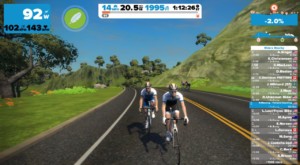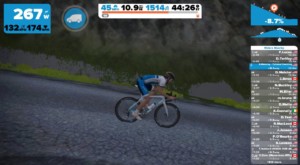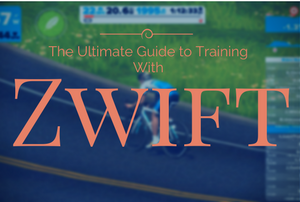Indoor cycling training has been changed forever since the introduction of Zwift. For those of you who are unaware, Zwift is an online platform for “virtual” riding and training. It is set in a variety of places, from the London and Richmond UCI World Championships courses to an island in the south pacific known as “Watopia.” Wherever you end up riding, you'll be thrown together with thousands of other cyclists from around the world. It only takes a few cheap pieces of technology to interface with the program. Once connected, each cyclist can pedal on their own or join friends from around the world in a virtual training environment.
Nobody has to worry about bad weather, traffic, flat tires (hopefully!) or wearing the right clothing. Everything is accomplished from your own trainer in your own home.
But what is it that makes Zwift such an efficient indoor cycling training tool? How can you use it to improve your fitness more than you ever imagined? I'll guide you through a ton of different ways to use Zwift. I'll give you a bunch of ways to add variety to your workouts and get the most out of your free riding time.
Click through the jump and start learning how to build the best fitness possible with Zwift:
Training Considerations | Fartlek Training | Group Training | FTP Testing | Skills Training | Learning Techniques | Racing | KOM and Sprint Points | Using the Workout Builder
Indoor cycling training considerations
Indoor cycling training is about building specific skills instead of simply putting in mileage. Time on the trainer should be spent working on very specific fitness adaptations that can be utilized later on in your training progression. In fact, trainer sessions are one of the keys to building a solid base. For more information on base building, check out my post on building a functional cycling base and my post on effective base training.
Indoor training, such as trainer rides or roller sessions are not the place for long, drawn out zone 2 efforts. Save the longer outdoor days for the zone 2 training and use your trainer time wisely. Zwift makes specific skills work much more “real world” than in the past. Especially when using a [easyazon_link identifier=”B01GA6Z8FO” locale=”US” tag=”taicoaandthed-20″]smart trainer[/easyazon_link], indoor cycling training on Zwift is like training out on the roads.
Doing interval work on open roads with variable terrain is much more effective than on a regular trainer. The variation in terrain forces your body to switch cadences, change zones temporarily and recover during an interval. While using Zwift, you can get all this and still create specific physiological adaptations because of the highly controlled trainer environment.
So, what kind of training can you do on Zwift?
 Fartlek Training
Fartlek Training
Fartlek training was developed in 1937. In Swedish it means “speed play” and it involves disorganized high-intensity training. Intervals are usually embedded within a longer block of lower intensity or sweetspot type of work. In essence, Fartlek training involves a lot of repeatability and over/under type work. Head out into rolling terrain or jump into a group ride if you want some disorganized training. You'll get plenty of intensity and the variable interval and rest length will keep your body guessing.
Zwift is the perfect platform for Fartlek training because other cyclists exist in your training space. Those other riders train at varying levels of fitness, which means you can ride with people who are faster or slower than you. You can ensure an easier day or you can ensure a harder day just by picking who you chase.
For example, if you're doing a sweetspot workout, you can get some repeatbility work with the people around you. When someone rides by you going a little bit faster, chase up to them and jump on their wheel. Hang there for a minute, then drop back to sweetspot intensity. You can repeat this interval over and over when someone passes you.
Watch the video about Fartlek training in Zwift for a little more information.
Group training and tactics on Zwift
Group training is another kind of training you can do fairly efficiently with Zwift. By jumping into any of the many group rides, you'll be doing a longer sweetspot or FTP workout. Generally, these groups are based on your W/Kg measurement. There's a range that is specified, often something like 2.5 W/Kg to 3.0 W/Kg. If you're just below that range, you may find the group ride challenging and motivating. After all, nobody wants to get dropped off the back of any kind of group ride.
The nice thing about a group ride is you get to test your tactics in a virtual environment before going out on the road. You'll learn how to draft and how drafting can save you some effort (assuming you're using a smart trainer.) At some point, you'll want to test your fitness by going on the attack (only when the group leader expressly allows it of course!) and trying to get away from the rest of the group. Finally, you can use the group to practice some paceline work, pulling through, taking a turn on the front and pulling off shortly after.
Long form intervals and FTP testing
Zwift island is one of the perfect places for longer intervals and Functional Threshold Power testing. Since the introduction of the mountain climb, Zwift has a perfect place to do longer intervals. This is doubly true if you're using a smart trainer due to the intensity requirements of the climb.
The mountain climb can be tackled in either direction, with the longer and easier side coming off the ocean loop. The steeper, harder side of the mountain is accessible from the marina area. No matter which way you approach it, the mountain climb will typically take you between 25 and 35 minutes to complete. This is the perfect duration of time to do FTP intervals and muscular endurance intervals. Because a [easyazon_link identifier=”B0112VE4NO” locale=”US” tag=”taicoaandthed-20″]smart trainer[/easyazon_link] will ramp up the resistance as you climb, you'll have lots of opportunities to increase pedal tension and reduce your cadence. Depending on how hard you go, everything from endurance to sweetspot intervals to FTP level workouts can be accounted for.
If you're looking to simulate a true climb and you're not on a smart trainer, you'll note that the mountain has a variety of “gradients”. These changes in gradient can remind you to get out of the saddle and push harder on the pedals to maintain speed. This is a perfect example of over/under work. You ride at a set intensity, increase it for a short period of time and drop back to the previous intensity. It's most effective when your set intensity is under your functional threshold power and the short increases are VO2 max level power.
The other perfect use for the mountain climb is to test your functional threshold power. Simply climb the mountain as hard/fast as you can while trying to keep as even as possible pace/power. You'll know a good functional threshold power test when you see a VI around 1.0 for your best 20 minutes. That means your overall intensity was fairly even and you can use the resulting value as a decent FTP testing number.
 Learn neuromuscular skills
Learn neuromuscular skills
If you're spending time on the indoor trainer, one of your goals should be neuromuscular technique development. These neuromuscular techniques are sometimes referred to as “speed work” or “speed skills.” They are one of the foundations of good fitness and are important for later training success. The trainer is the perfect place to work on these: it's a safer more easily controlled environment.
Zwift makes neuromuscular work a lot easier to perform. The volcano loop is a great place to do neuromuscular work or technique work because it is relatively flat. You can do a variety of workouts such as superspins, spinups and single leg work on the flatter sections. A variety of “singlespeed” work can be done on the voclano loop as well. Just keep it in one gear and let the terrain dictate your cadence. I've detailed the singlespeed workout in this post, so check it out and get an idea of how to execute it effectively.
The Mayan expansion is another great place to build neuromuscular skills. The up and down nature of the Mayan loop lets you train low cadence, high cadence and everything in between. You just have to be a little bit creative on how you use your time in the ruins.
The mountain climb is another great place to practice neuromuscular work. Especially with a smart trainer, you'll be forced to pedal quickly downhill. Every 30 seconds, ramp up your cadence as fast as you can go and hold it there. By keeping your intensity low, you'll build some great neuromuscular gains while getting a little bit of rest too.
Riding techniques
Another big benefit of the controlled nature of Zwift (especially with a smart trainer) is the ability to practice critical cycling techniques. Situations such as rolling climbs, bridging gaps, attacking and covering attacks are simple on Zwift. You have plenty of other riders to use as “rabbits” for attacks and bridges. You have lots of faster riders to practice covering their attacks. There are plenty of small rollers for you to practice rolling your climbs, and the virtual dashboard gives you immediate feedback as to the effectiveness of this technique.
Sitting on the trainer is also a great opportunity to form some good habits, especially breathing habits. It's very common to see people start panting as they get tired. As I detailed in some of my previous articles about breathing techniques, this is detrimental to your performance. Use your indoor cycling training time to start practicing how to breathe properly. If you're not completely sure what I'm talking about, check out some tips in my blog posts breathing techniques for cyclists part 1 and breathing techniques for cyclists part 2.
Building these good habits now will pay dividends later outside. But until you get outside and start competing, you can do some racing on Zwift.
“Racing” forces you to push beyond your boundaries
Racing on Zwift is another way to get some great intense workouts. Just like real life, racing challenges you to be at your strongest. It will also force you to be smarter than if you're doing regular training. If you spend too much time on the front or moving up through the pack, you'll tire out quickly and be shelled. All these factors make racing on Zwift a great choice for building fitness. After all, the old saying goes “training is racing and racing is training.” Of course, you don't have to jump into the equivalent of a professional race to get some saddle time.
Of course, you don't have to jump into the equivalent of a professional race to get some saddle time. Most of the races are broken down by FTP and W/Kg. This makes sure that you're not stuck with the monsters if you're just starting out. You'll get put into a handicap that's challenging but fair if you're willing to lay down some hurt. And some hurt can be a good thing. Just the fact that you're racing will make you push a little bit harder and work a little more to stay on the wheel.
Chances are whatever race you're entered into will give you more Zone 5, 6 and 7 work than you would get on your own. For that reason alone, racing on Zwift a few times per month can be beneficial to your fitness.
Check out the racing schedule on ZwiftBlog and pick something that will challenge you.
KOM points and sprint points
Each Zwift race course has a number of built-in King Of The Mountain points and sprint points. These are a great way to test your fitness in an impromptu setting. You can also see if you're on par for your daily training or not.
The KOM and sprints offer a fantastic psychological challenge for you while working on zone 5, 6 and 7 efforts. Everyone wants to move up the leaderboard at the sprint points. Nobody wants to see their name fall down the KOM list. These mental factors help you push harder during your efforts and give that extra 1% in your training.
How do you use the KOMs and sprints for training? Any KOM point between 3 and 8 minutes makes the perfect place to do VO2 max and zone 6 type work. The shorter the KOM, the harder you can push. Sprint points are a prime proving ground for learning how to sprint. Not only can you train and test neuromuscular power and endurance, you can learn how to get the right gear combination and proper cadence to sprint effectively.
Perhaps one of the biggest uses of these points is seeing improvement (or fatigue.) Zwift keeps a 30 day running tally of your attempts. By watching those you can determine if your training is working or if you're just stagnant.
Workout builder and pre-built workouts
Finally, I've talked about the Zwift custom workout builder in the past. You simply have to know your objective to build it into the workout builder. Really, the sky is the limit for this handy little tool.
A pretty cool way of using the workout builder that I've been experimenting with is using it to simulate the kind of event I'll be doing. For example, if I'm racing a road race, I can build a workout with a fast start. That fast start is followed by some tempo work, a couple of attacks, a breakaway attempt, some more tempo, ramping up and then a sprint.
With some creativity, you can simulate everything from TTs to criteriums to road races in the workout builder.
You can also build workouts that target specific training adaptations. For an idea of some of these workouts, check out my Zwift workout page.
Use your imagination
Training with Zwift is only limited by your imagination. Zwift has proven that indoor cycling training doesn't have to be boring anymore. All you have to do is look at the terrain in front of you and ask “what am I trying to accomplish?” Once you know what your workout goal is, you can easily find a way to accomplish it. There are so many options available in Zwift, and the use of a [easyazon_link identifier=”B0112VE4NO” locale=”US” tag=”taicoaandthed-20″]smart trainer[/easyazon_link] makes it so similar to riding outside. The combination of the indoor, controllable training environment and variation of resistance on a smart trainer is the perfect combination.
If you need help with getting your Zwift training down pat, don't hesitate to contact me and I'll help you out!
